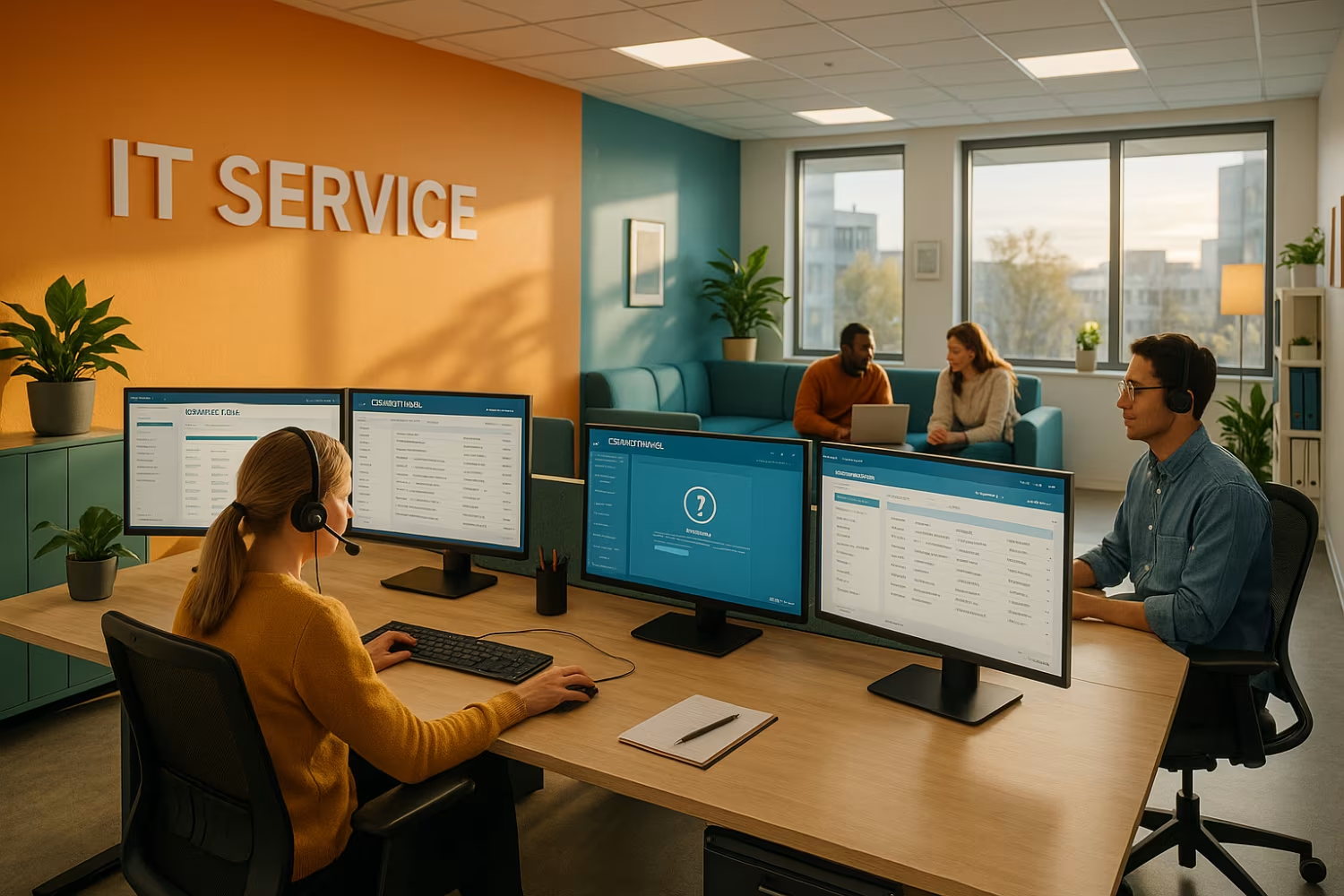IT Service Desk: Help Desk, ITSM & Automation Best Practices
George Grubor


Modern businesses rely on efficient support systems to keep operations running smoothly. An IT service desk plays a key role in managing user issues, service requests, and IT operations. In this article, we’ll explain what an IT service desk is, how it differs from a help desk, and how it fits into broader IT service management (ITSM) strategies. You’ll also learn about service desk software, automation, and helpdesk best practices to improve support for your team and customers. Topics like self-service, incident management, and SLAs will also be covered.
What is an IT service desk?
An IT service desk is a central hub where users can report issues, request services, and get help with IT systems. It supports both internal employees and external customers by managing service requests and incidents. Unlike a basic help desk, which often focuses only on fixing problems, a service desk covers a wider range of IT support functions.
The IT service desk is a core part of ITSM. It helps businesses follow structured processes to handle requests, track issues, and resolve them efficiently. With the right service desk software, organizations can streamline workflows, reduce downtime, and improve user satisfaction.

Key differences between service desk, help desk, and ITSM
Understanding the differences between these terms helps businesses choose the right support model. Here’s a breakdown of each:
Service desk scope and purpose
A service desk is designed to handle all IT-related requests and incidents. It supports broader ITSM goals and often includes features like change management and asset tracking.
Help desk basics
A help desk is more limited in scope. It typically focuses on break/fix support and may not include advanced features like configuration tracking or service catalogs.
ITSM framework
ITSM is a set of practices for delivering IT services. It includes processes like incident management, change management, and problem management. The service desk is a key component of ITSM.
Integration with other systems
Service desks often integrate with tools like configuration management databases (CMDBs) and monitoring systems. Help desks may not have these integrations.
End user experience
Service desks usually offer better self-service options and knowledge bases, making it easier for users to find answers without contacting support.
Workflow and escalation
Service desks follow structured workflows and escalation paths. This ensures that issues are resolved at the right level and within defined SLAs.
Reporting and metrics
Service desks provide detailed reporting on performance, helping teams track SLAs, identify trends, and improve service delivery.
Top features to look for in a modern IT service desk
A reliable IT service desk should include features that support both users and IT teams:
- Ticket management: Track and manage service requests and incidents from start to finish.
- Knowledge base: Provide users with self-service options through searchable articles and FAQs.
- Automation tools: Automate repetitive tasks like ticket routing, approvals, and notifications.
- Service catalog: Let users request services through a structured, easy-to-use interface.
- SLA tracking: Monitor service levels and ensure timely resolution of issues.
- Integration support: Connect with other IT tools like asset management and monitoring systems.

How service request management improves efficiency
Service request management is a structured process for handling user requests, such as software installations or access permissions. By organizing these requests through an IT service desk, businesses can reduce delays and ensure consistent service delivery.
This process also helps IT teams prioritize tasks, track progress, and meet service level agreements (SLAs). When combined with automation, service request management can significantly reduce manual work and improve response times.
Best practices for service desk and help desk operations
Running an effective IT service desk requires more than just software. It involves following best practices that align with business goals and user needs:
Clear ticket categorization
Organize tickets by type, priority, and department to streamline routing and resolution.
Use of a knowledge base
Encourage users to search for answers before submitting tickets. This reduces workload and improves user satisfaction.
Regular training for staff
Keep support teams updated on tools, processes, and new technologies to maintain high service quality.
Defined escalation paths
Set clear rules for when and how to escalate issues to higher support levels.
SLA monitoring
Track performance against SLAs to ensure timely responses and identify areas for improvement.
Feedback collection
Ask users for feedback after ticket resolution to improve service quality and identify recurring issues.

Practical steps to implement a new IT service desk
Implementing an IT service desk takes planning and coordination. Start by identifying your business needs and choosing software that fits your environment. Look for tools that support automation, self-service, and integration with existing systems.
Next, define your workflows and escalation paths. Train your team on how to use the system and follow best practices. Finally, monitor performance using metrics like resolution time, ticket volume, and user satisfaction to make ongoing improvements.
Helpdesk best practices for long-term success
Following helpdesk best practices ensures your IT service desk continues to deliver value over time:
- Document processes: Keep workflows and procedures up to date for consistency.
- Review SLAs regularly: Adjust service levels based on business needs and user expectations.
- Use automation wisely: Automate repetitive tasks but keep human oversight for complex issues.
- Encourage self-service: Promote use of the knowledge base and service catalog.
- Analyze ticket trends: Use data to identify recurring problems and prevent future issues.
- Stay flexible: Be ready to adapt your service desk as your business grows or changes.

How IT's UpTime can help with IT service desk
Are you a business with 10–120 employees looking to improve your IT support? Our team works with growing companies to implement IT service desk solutions that scale with your needs. Whether you're starting from scratch or upgrading an existing system, we can help you get set up quickly and efficiently.
We understand the challenges of managing IT support in a growing business. That’s why we offer tools and services that simplify ticket tracking, automate workflows, and improve user satisfaction. Contact us today to learn how IT's UpTime can support your team.
Frequently asked questions
What’s the difference between a service desk and a help desk?
A help desk focuses on solving immediate technical issues, like password resets or software errors. A service desk handles a broader range of IT services, including service requests, change approvals, and asset tracking.
The service desk is part of a larger service management strategy. It often includes tools like a configuration management database (CMDB) and supports workflows that help streamline IT operations.
How does service management improve IT support?
Service management uses structured processes to deliver consistent IT services. It includes practices like incident management, change management, and problem resolution.
By following ITIL guidelines, service management helps teams meet SLAs and improve the end user experience. It also supports better planning and resource allocation.
What is ITSM and why does it matter?
ITSM stands for IT service management. It’s a framework for managing and delivering IT services in a structured way. ITSM includes processes like service request handling and change control.
Using ITSM helps businesses align IT services with business goals. It also improves efficiency, reduces downtime, and enhances user satisfaction.
How do I manage service requests effectively?
Use service desk software to organize and track service requests. A good system will let users submit requests through a service catalog and route them to the right team.
Automation can help by assigning tickets based on category or priority. This reduces delays and ensures requests are handled within SLA timelines.
What features should I look for in service desk software?
Look for features like ticket tracking, knowledge base integration, and SLA monitoring. A good platform should also support automation and self-service.
Integration with asset management and incident tracking tools is also useful. These features help streamline support and improve visibility across systems.
How can automation improve help desk and service desk operations?
Automation reduces manual work by handling repetitive tasks like ticket routing, notifications, and approvals. This speeds up response times and reduces errors.
It also helps teams focus on more complex issues. When combined with clear workflows and escalation paths, automation improves overall service quality.









